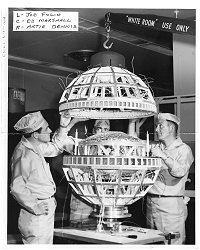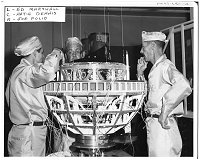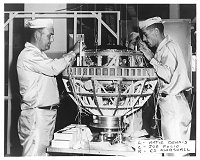
Telstar
From: https://www.nasa.gov/topics/technology/features/telstar.html
J. R. Pierce and his associates at Bell Labs worked throughout the second half of the 1950’s on satellite communications concepts. In the fall of 1960, AT&T began development of a satellite communications system called Telstar. The operational system would consist of “between 50 and 120 simple active satellites in orbits about 7,000 miles high.” Using large launch vehicles that were then being developed, it was envisioned that “a dozen or more of these satellites could be placed in orbit in a single launching.” With the satellites in random orbits, Bell Labs figured that a “system of 40 satellites in polar orbits and 15 in equatorial orbits would provide service 99.9 per cent of the time between any two points on earth. AT&T has proposed that the system contain about 25 ground stations so placed as to provide global coverage.” (Pierce, pg. 101)
The cost of such a system would be high, Pierce estimated it at $500 million in his 1961 article, but that was not a detriment from AT&T’s standpoint. As a monopoly at the time, AT&T’s rates were regulated. These rates included an amount that allowed AT&T to recover its costs as well as make a profit. The costs of the satellite system would be passed on to consumers just as the high costs of undersea cables were. Higher cost investments by the monopoly allow higher profits, so the complex Telstar system was attractive to AT&T.
Bell Telephone Laboratories designed and built the Telstar spacecraft with AT&T corporate funds. The first Telstars were prototypes that would prove the concepts behind the large constellation system that was being planned. NASA’s contribution to the project was to launch the satellites and provide some tracking and telemetry functions, but AT&T bore all the costs of the project reimbursing NASA $6 million. Although Telstar was not really a NASA project, NASA was able to negotiate an excellent deal with AT&T because NASA held a monopoly on launch services. NASA was able to claim Telstar as a NASA supported project and even publish the report on the results of experimentation as a NASA publication (SP-32, a reprint of the Bell System Technical Journal articles about the project), as well as getting rights to any patentable inventions arising from the experiments.
NASA’s Chief of Communications Satellite Programs wrote in 1966:
Although not the first communications satellite, Telstar is the best known of all and is probably considered by most observers to have ushered in the era of satellite communications. This impression was a result of the tremendous impact upon the public by the first transmission of live television across the Atlantic Ocean. Telstar I was launched on July 10, 1962, and on that same day live television pictures originating in the United States were received in France. (Jaffe, pg. 107)
A statement by President Eisenhower in December 1960 layed out his policy on space communications:
This Nation has traditionally followed a policy of conducting international telephone, telegraph, and other communications services through private enterprise subject to governmental licensing and regulation. We have achieved communications facilities second to none among the nations of the world. Accordingly, the Government should aggressively encourage private enterprise in the establishment and operation of satellite relays for revenue-producing purposes.
To achieve the early establishment of a communication satellite system which can be used on a commercial basis is a national objective which will require the concerted capabilities and funds of both Government and private enterprise and the cooperative participation of communications organizations in foreign countries.
Various agencies of Government, including the Department of State, the Department of Defense, and the Office of Civil and Defense Mobilization, have important interests and responsibilities in the field of communications.
With regard to communication satellites, I have directed the National Aeronautics and Space Administration to take the lead within the executive branch both to advance the needed research and development and to encourage private industry to apply its resources toward the earliest practicable utilization of space technology for commercial civil communication requirements. In carrying out this task NASA will cooperate closely with the Federal Communications Commission to make certain that the high standards of this Nation for communications services will be maintained in the utilization of communication satellites. (Musolf, pg. 17-18)
Eisenhower policy had been to allow private enterprise (in the form of AT&T) to develop satellite communications. Kennedy policy was not to allow a monopoly (like the one AT&T then enjoyed in terrestrial communications) in space communications. NASA had several factors that had to be considered in its support of satellite research and development. There were many different players in the government arena alone. The responsibility for active communications satellites rested with the military according to a 1958 agreement. In August 1960, NASA decided to pursue active satellite research, but left synchronous satellites to the military since Project Advent was already in place. Although AT&T and Hughes had both approached NASA with their concepts, NASA, as a government bureaucracy, had regulations and laws to follow. NASA issued a request for proposals on January 4, 1961 for an experimental communications satellite. In May NASA selected RCA for the Relay project over AT&T and Hughes.
Although it became clear by early 1961 that the policies developed by NASA and the FCC were not specifically designed to provide the easiest route for AT&T dominance in the communications satellite field, AT&T’s preeminent position as the largest U.S. common carrier and sole international telephone carrier, together with its willingness and financial ability to commit large sums to the development of communication satellites, combined to give the image that commercial satellite utilization would very likely become AT&T utilization. Concern over the possibility of an AT&T monopoly was one factor that prompted a later reorientation of the direction that commercialization seemed to be following. (Smith, pg. 74)
President Kennedy released a policy statement on July 24, 1961 which favored private ownership of satellite systems, but with features that would avoid a monopoly:
A. Policy of Ownership and Operation
Private ownership and operation of the U.S. portion of the system is favored, provided that such ownership and operation meet the following policy requirements:
- New and expanded international communications services be made available at the earliest practicable date;
- Make the system global in coverage so as to provide efficient communication service throughout the whole world as soon as technically feasible, including service where individual portions of the coverage are not profitable;
- Provide opportunities for foreign participation through ownership or otherwise, in the communications satellite system;
- Non-discriminatory use of and equitable access to the system by present and future authorized communications carriers;
- Effective competition, such as competitive bidding, in the acquisition of equipment used in the system;
- Structure of ownership or control which will assure maximum posssible competition;
- Full compliance with antitrust legislation and with the regulatory controls of the government;
- Development of an economical system, the benefits of which will be reflected in overseas communication rates.
(Kennedy, pg. 530)
Telstar 1 was launched on July 10, 1962 into a 514 x 3051 nmi. orbit by a Delta launch vehicle. The spacecraft weighed 171 pounds (the Delta capability was for a maximum payload of 180 pounds). The shape was a faceted sphere with a diameter of a little over 34 inches. Of six spacecraft built, two were launched. The solar cells provided just under 15 watts. The spacecraft was spin stabilized using the same rate as the third stage (typically 200 rpm) avoiding a despin mechanism. The receive and transmit antennas consisted of belts of small apertures (72 and 48 respectively) around the middle of the spacecraft resulting in a circularly polarized antenna with an isotropic pattern around the equator of the spacecraft. Frequencies used were 6,390 MHz uplink and 4,170 MHz downlink. Telstar was the first satellite to use a TWT amplifier since transistor technology at the time was not capable of the 3 W power output at the frequency required. (SP-32, pg. 801-830)
AT&T built a ground station in Andover, Maine (away from microwave repeaters to avoid interference) similar to, but larger than, the ground station used for Echo. A French station at Pleumeur-Bodou used a duplicate of the AT&T horn antenna while the British station at Goonhilly Downs used a parabolic dish. The satellite was in position for transatlantic relay for a maximum of 102 minutes per day. Telstar relayed the first live trans-Atlantic television transmission as well as picture facsimile, telephone, and data relay. On July 9, the day before the Telstar I launch, the U.S. conducted a high altitude nuclear test (Starfish). Telstar’s orbit took it through the Earth’s inner radiation belt as well as a small portion of the outer belt. The radiation exposure was increased by the Starfish nuclear explosion as well as by a Soviet test in October 1962. After four months of successful operation, some transistors in the command system succumbed to the radiation. A workaround was successful in reviving the spacecraft for two more months.
AT&T’s Telstar was not only a tremendous technical success, but the international reaction was spectacular. A U.S. Information Agency poll showed that Telstar was better known in Great Britain than Sputnik had been in 1957. Rather than launching a useless bauble, the Americans had put into orbit a satellite that promised to tie together the ears and eyes of the world. Interestingly, the world saw Telstar as an undertaking of the United States (U.S. Information Agency publicity may have helped). President Kennedy hailed Telstar as “our American communications satellite” and “this outstanding symbol of America’s space achievements."(Cunniffe, pg. 29)
President Kennedy released a statement on Telstar on July 11, 1962:
The successful firing and subsequent operation of the Telstar communications satellite is an outstanding example of the way in which government and business can cooperate in a most important field of human endeavor. The achievement of the communications satellite while only a prelude already throws open to us the vision of an era of international communications. There is no more important field at the present time than communications and we must grasp the advantages presented to us by the communications satellite to use this medium wisely and effectively to insure greater understanding among the peoples of the world.
Even as the success of Telstar I was becoming apparent, AT&T lost the chance to control commercial satellite communications. On August 31, 1962 President Kennedy signed the Communications Satellite Act which gave a monopoly on internation communications via satellite to a new corporation called Comsat. AT&T went ahead with Telstar II anyway to complete its experimental program. It was launched on May 7, 1963. The publicity from Telstar had been very positive for AT&T.
AT&T had built six flightworthy spacecraft and launched two of them using company funds. Bell Labs had developed much of the technology required for satellite communcations including transistors, solar cells, and TWT amplifiers. AT&T also built ground stations for Echo and Telstar.
Although some observers felt that AT&T’s early interest in communication satellites was part of a defensive maneuver and that its main commitment was actually with cable, AT&T did manage with its own capital to get a satellite program moving. (Smith, pg. 71).

The following photos and National Geographic article were contributed by Arthur Dennis, a website visitor whose father worked on the Telestar project at Bell Labs. His father is now 81yrs old (in 2005) and has always been very proud of being part of the Telstar project. He retired 20 yrs. ago. Arthur worked 29 years. and retired 6 years ago from then Bell Atlantic. Click on photos below to enlarge.
National Geographic ** **article

We Offer Personalized One-On-One Service!
Call Us Today at (651) 787-DIAL (3425)




Reliable, secure high-speed internet
With CenturyLink Simply Unlimited Internet, you can choose from a wide range of available speeds that fit your online needs. Plus, you can connect several devices with super-fast in-home WiFi.
Order Now







